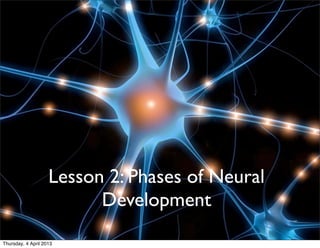
Lesson 2 phases of neural dvelopment 2013
- 1. PHASES OF NEURAL DEVELOPMENT IN LEARNING Lesson 2: Phases of Neural Development Thursday, 4 April 2013
- 2. Previous Lesson Exam Question 2012 VCAA Exam Thursday, 4 April 2013
- 3. Model Response VCAA Assessors Report 2012 Thursday, 4 April 2013
- 4. Outcomes (What you need to know and be able to do) • Explain the neural pathways involved in learning, synapse formation, and the roles of various neurotransmitters Thursday, 4 April 2013
- 5. Why is learning important............ Thursday, 4 April 2013
- 6. Why is learning important............ It is crucial to SURVIVAL Thursday, 4 April 2013
- 7. Donald Hebb (1946) Theorised that when two neurons are jointly activated they become more closely linked ʻneurons that fire together wire togetherʼ This creates neural pathways (neural circuits) which are an interconnected groups of neurons organised as a network that is active during the learning process Thursday, 4 April 2013
- 8. Zygote (single cell) Cells multiply They differentiate (become specialised) Cells must form relationships with cells around them - They form synapses in a process called synaptogenesis Thursday, 4 April 2013
- 9. Synaptogensis Synaptogensis occurs throughout a healthy person’s lifetime This happens rapidly from 2months before birth - 2years of age Thursday, 4 April 2013
- 10. Effects of Experience on Neural Development Genetics alone do not determine neural development Experience plays a part in neural development Hebb proposed that use of neurons improved their function ‘Use it or loose it’ Thursday, 4 April 2013
- 11. Studies Supporting the Hebb idea Animals reared in the dark (Cragg, 1976) were found to have fewer synapses and fewer dendrites in their visual cortices Rats raised in a enriched environment show greater synapse formation and grater dendrite development Kandel’s research and LTP theory Thursday, 4 April 2013
- 12. What is LTP again.......... Thursday, 4 April 2013
- 13. What is LTP again.......... The long-lasting strengthening of synaptic connections resulting in enhanced function of neurons along a neural pathway whenever activated Thursday, 4 April 2013
- 14. What is LTP again.......... The long-lasting strengthening of synaptic connections resulting in enhanced function of neurons along a neural pathway whenever activated LTP is a crucial mechanism of learning: Learning may not be possible without it Thursday, 4 April 2013
- 15. The role of neurotransmitters in learning NT’s involved in learning: Glutamate: Strengthens connections at the synapse during learning Dopamine: May be involved through rewarding ‘pleasure’ experience. Acetylcholine: Present in some learning experiences but specific role unclear Thursday, 4 April 2013
- 16. Activity 1 - Create a poster 1. Hand draw or use a computer program to represent the following: - Create a flow chart to show the neural steps involved in learning (Include the following: the creation of new pathways, synaptogenesis, neurotransmitters) Thursday, 4 April 2013
